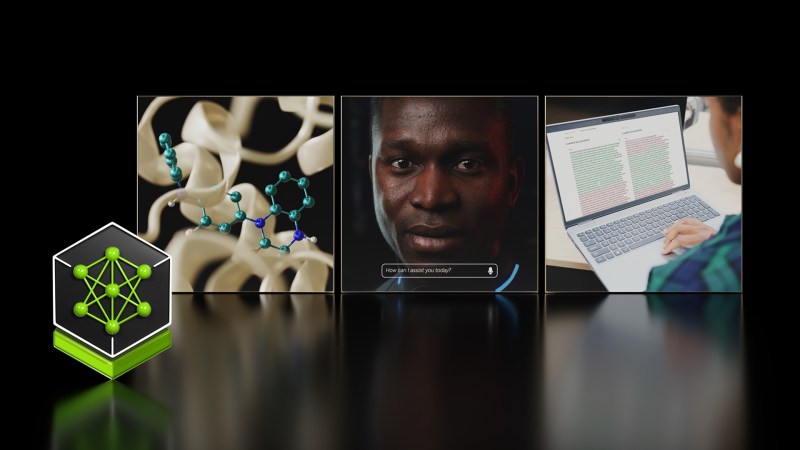Join our daily and weekly newsletters for the latest updates and exclusive content on industry-leading AI coverage. Learn More
Today, Nvidia announced the launch of NIM Agent Blueprints, a catalog of AI workflows and software resources designed to accelerate the development and deployment of generative AI-powered agents and applications.
Available as a free-to-download offering, the blueprints touch canonical use cases such as customer service avatars, drug discovery and data extraction from documents.
Developers can work with these using their datasets to quickly get started and deploy agents tailored to their respective business functions. Nvidia also plans to add resources for more applications soon.
The move from the Jensen Huang-led company comes as enterprises across sectors continue to remain bullish on the prospects of generative AI and how it can boost productivity, saving time and money. Nvidia is even working with several technology solutions providers and global system integrators to ensure seamless access and deployment of the blueprints.
According to McKinsey, the deployment of generative AI by enterprises could yield $2.6 trillion to $4.4 trillion annually in value across more than 60 use cases.
What do NIM Agent Blueprints bring to the table?
While enterprises have been tapping generative AI for tasks like content generation and summarization for quite some time, many teams are looking to go beyond standard use cases with applications using one or more AI agents, backed by their proprietary data. The customized agents are being hailed as the second wave of gen AI (with immense growth potential), but building and deploying them continues to be a complex, multi-step process.
Most organizations continue to struggle with this issue, leading to delays and cash burn.
With the new NIM Agent Blueprints, Nvidia is giving teams everything they need to accelerate these workflows, right from sample applications built with Nvidia NIM, NeMo and partner microservices, reference code, customization documentation and a Helm chart (which combines YAML files and templates to define the necessary configurations) for deployment.
Using the pre-trained AI workflows in the blueprints, developers can easily jumpstart the complex development process and deploy their agentic applications across accelerated data centers and clouds. They can modify the blueprints using proprietary data, allowing developers to tap both information retrieval and agent-based workflows capable of performing complex tasks.
On top of this, as users interact with these applications, the blueprints can also be enhanced, creating a continuous learning cycle leading to better performance over time.
Three blueprints available, more to come every month
Currently, Nvidia is providing enterprises with three major blueprints to work with: digital human for customer service, generative virtual screening for accelerated drug discovery and multimodal PDF data extraction for enterprise RAG.
The blueprint for customer service allows enterprises to build 3D avatar-based customer service agents using Nvidia ACE, Omniverse RTX, Audio2Face and Llama 3.1 NIM microservices. Meanwhile, the offerings for drug discovery and data extraction incorporate Nvidia NeMo Retriever, NIM microservices — including AlphaFold2, MolMIM and DiffDock — and Nvidia BioNemo.
“More NIM Agent Blueprints are in development for creating generative AI applications for customer service, content generation, software engineering, retail shopping advisors and R&D. Nvidia plans to introduce new NIM Agent Blueprints monthly,” Justin Boitano, who leads enterprise data center business at Nvidia, wrote in a blog post.

Notably, for each of these blueprints, Nvidia is also simplifying access and deployment.
For access, the company has partnered with several technology solution providers, including Deloitte, Accenture, SoftSeve and World Wide Technology (WWT). These providers will add the blueprints to their respective portfolios, making them easily available to enterprise customers.
“By integrating NVIDIA’s catalog of workflows into Accenture’s AI Refinery, we can help our clients develop custom AI systems at speed and reimagine how they do business and serve their customers to drive stronger business outcomes and create new value,” Julie Sweet, chair and CEO of Accenture.
On the other hand, for enterprises looking to go on their own and deploy custom blueprints in the data center or cloud, Nvidia is providing full-stack accelerated infrastructure support from its global partners. This includes Nvidia-certified systems from Cisco, Dell Technologies, Hewlett Packard Enterprise and Lenovo as well as Nvidia-accelerated cloud instances from Amazon Web Services, Google Cloud, Microsoft Azure and Oracle Cloud Infrastructure.
Source link

